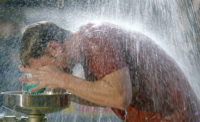
In many splash or spray incidents, eyewashes and eye/face washes are the initial response mechanism. These important pieces of equipment are tasked with diluting and/or removing the hazardous materials, mitigating further injury.
Proper selection of emergency equipment is a function of knowing your risks, the characteristics of the materials you work with and logical consideration of the variety of products and design configurations available.
ANSI Z358.1
The American National Standards Institute (ANSI) provides a guide to aid manufacturers, consumers and the general public relative to Emergency Eyewash and Shower Equipment. The Standard, Z358.1-2009, is prefaced by advice regarding the need for proper protection of employees and others to minimize the risk of hazardous exposure. It also advises those concerned with compliance to obtain specific local medical input regarding risks and countermeasures.
This article is not meant to be an interpretation of ANSI Z358.1, nor is it intended to replace the advice of a competent medical professional. Instead, the following information is aimed at developing a logical thought process that comprehends many of the circumstances and alternatives of your specific eyewash and/or eye/face wash applications.
Consider your potential exposure
Review your operation from the perspective of the materials your employees handle, the volatility of those materials and the likelihood of spill or splash accidents that may injure employees or others:
- Are spill, splash and airborne contaminant safeguards, like aprons, gloves and goggles, adequate?
- In the event of an accident, are emergency equipment facilities available within ten seconds of potential accident sites, with unobstructed pathways to them? Are they located on the same level as the potential accident sites?
- Are your employees aware of - and practiced in the use of - safeguards, first aid and appropriate countermeasures?
- Are eyewashes and eye/face washes properly maintained and tested weekly?
- If you are working with a new installation or a renovation, do you have an adequate numbers of eyewash and/or eye/face wash stations? Remember to consider the possibility of multiple injuries from a single accident. Are emergency facilities properly located? Properly signed and visible?
- Do you need eyewashes, eye/face washes or both? This can be a reasonably challenging question. Consider the hazardous materials in use. A single drop of caustic material, for example, might splash on a counter top and bounce up into an employee’s eye. This might require an eyewash.
Likewise, many airborne contaminants might irritate the eyes only, again with an eyewash being the answer.
However, don’t forget that one of the main functions of an eyewash or eye/face wash is to dilute the hazardous substance. Larger scale spills and splashes of hazardous materials that could cause injury to the face, as well as the eyes, would naturally drive the need for eye/face washes. Most safety professionals agree that one should err on the side of caution – if in doubt, specify an eye/face wash.
Weigh your alternatives
For the purpose of this review, we will categorize the elements to consider into five groups, assuming that you’ve already made your choice between eyewash and eye/face wash:
1 Flow characteristics and pressure
After you’ve decided between an eyewash and eye/face wash, stop and consider that piece of safety equipment in actual use.
Consider the height of the flow. A zero vertical velocity stream is ideal because of the water streaming stopping point and where the user needs to place their face. The 2009 ANSI Standard now mandates that when placing the testing gauge in the stream of the eyewash the flushing fluid shall cover the areas between the interior and exterior lines of the gauge at some point less than 8 inches above the eyewash nozzle. Also, pay close attention to the design of the spray nozzles. While perhaps not as important in eyewashes, eye/face washes often must flow significantly more water. This should drive the use of a diffused design to cushion the flow as much as possible.
One often-overlooked feature is the pressure control valve. You should also be aware the flow compensation portion buffers the flow in the likely event of air being present in the supply water line when activated. This keeps the flow steady during use. If the pressure and height of the flow is too high, the accident victim might shortcut the required irrigation time.
Once again, consider the victim’s level of comfort during use. An excessively strong pressure or poorly regulated flow would be too harsh and create unnecessary discomfort for the full 15-min flush required. A variety of different eyewash and eye/face wash products are available, with various designs, operating features and resultant price points.
2 Stream direction
The medical profession teaches and practices irrigating eyes by introducing the flushing fluid at the inner corner of the eye – adjacent to the nose – and letting it run across the eye to the outer edge. In effect, doctors irrigate eyes by moving the fluid away from the lacrimal puncta, which are the ocular cavity’s drains. These drains channel excess fluids (including hazardous substances accidentally splashed into the eye) directly into the nasal cavity where they can be swallowed or inhaled. The medical best-practice for eye irrigation is actually opposite the flow direction of traditional plumbed-in eyewash products. The appropriate approach for eyewash streams are inverted versus the traditional eyewash. Streams contact the eyes at the inner canthus or corner, adjacent to the bridge of the nose. Contaminants are swept to the outer edge of the eye, where gravity takes over running them into the eyewash bowl.
3 Consider “high coverage” products
In applications where an eye/face wash is specified, one should also consider the coverage area afforded by your ultimate product selection. As was illustrated earlier, the coverage difference between an eyewash and an eye/face wash is significant, by design. Specifiers should also be aware that there are high-coverage eye/face washes available. These products can provide about five times the coverage of a conventional eye/face wash in a package that is about the same overall size.
4 Construction and materials
Plastic versus stainless steel and plating versus no plating are a matter of personal preference, as well as need. Depending on the type of hazardous materials in use and the cleanliness of the environment, the choice of construction materials should be relatively easy.
5 Tepid water and engineered solutions
The ANSI Standard now specifies exact temperature range to guarantee proper flushing. Tepid is now defined as a flushing fluid temperature conducive to promoting a minimum 15-minute irrigation period, with a suitable range of 60-100 degrees Fahrenheit. Tepid water requirements are important in order to encourage users to complete the full 15-minute drench period.
The full 15-minute drench period helps prevent chemical absorption, cool burns and prevent hypothermia. It may be appropriate that you specify a complete system, including provisions for tempered water. More and more companies are addressing their precise needs in this and many other areas through collaboration with emergency equipment manufacturers.
Prepare the troops!
After all of the thought, planning and installations are completed, it is absolutely essential that we take steps to assure that employees know where to go and how to get emergency help when it’s needed. More than a matter of sending a memo, an active awareness and training program is invaluable in preparing employees for any eventuality.


